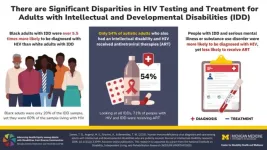Advanced artificial photosynthesis catalyst uses CO2 more efficiently to create biodegradable plastics
An innovative and more efficient way to produce fumaric acid that not only reduces carbon dioxide emissions, but also reuses waste resources to make biodegradable plastics
2024-02-16
(Press-News.org)
Amid growing global concern over climate change and plastic pollution, researchers at Osaka Metropolitan University are making great strides in the sustainable production of fumaric acid – a component of biodegradable plastics such as polybutylene succinate, which is commonly used for food packaging. The researchers have managed to efficiently produce fumaric acid, which is traditionally derived from petroleum, using renewable resources, carbon dioxide, and biomass-derived compounds.
In a previous study, a research team led by Professor Yutaka Amao of the Research Center for Artificial Photosynthesis at Osaka Metropolitan University demonstrated the synthesis of fumaric acid from bicarbonate and pyruvic acid, a biomass-derived compound, using solar energy. They also succeeded in producing fumaric acid using carbon dioxide obtained directly from the gas phase as a raw material. However, the yield in the production of fumaric acid remained low.
In their latest research, published in Dalton Transactions, the researchers have now developed a new photosensitizer and further advanced an artificial photosynthesis technique that doubles the yield of fumaric acid compared to conventional methods.
“This is an extremely important advancement for the complex bio/photocatalyst system. It is a valuable step forward in our quest to synthesize fumaric acid from renewable energy sources with even higher yields, steering us toward a more sustainable future,” said Professor Amao.
###
About OMU
Osaka Metropolitan University is the third largest public university in Japan, formed by a merger between Osaka City University and Osaka Prefecture University in 2022. OMU upholds "Convergence of Knowledge" through 11 undergraduate schools, a college, and 15 graduate schools. For more research news visit https://www.omu.ac.jp/en/ or follow us on Twitter: @OsakaMetUniv_en, or Facebook.
END
ELSE PRESS RELEASES FROM THIS DATE:
2024-02-16
A 280-million-year-old fossil that has baffled researchers for decades has been shown to be, in part, a forgery following new examination of the remnants.
The discovery has led the team led by Dr Valentina Rossi of University College Cork, Ireland (UCC) to urge caution in how the fossil is used in future research.
Tridentinosaurus antiquus was discovered in the Italian alps in 1931 and was thought to be an important specimen for understanding early reptile evolution.
Its body outline, appearing dark against the surrounding rock, was initially interpreted ...
2024-02-15
Trace metals are nutrient elements, like zinc, that animals and plants need in small amounts to function properly. Animals generally get trace metals in their diets or through environmental exposures, while plants take their trace minerals up from soil. If we get too little, we may experience a deficiency, but the opposite can also be true: too much of a trace metal can be toxic.
Scientists believe that up to 50% of the trace metals in soils and urban environments may be bound to the surfaces of mineral grains — rendering the trace metals ...
2024-02-15
Addressing Brain Health in Adults With Intellectual Disabilities and Developmental Disabilities: A Companion to the KAER Toolkit for Primary Care Providers is a new publication from the Gerontological Society of America (GSA) designed to address the needs of adults with intellectual and developmental disabilities (I/DD) who develop dementia.
Freely available at geron.org/brainhealth, this companion document:
Raises awareness of unique needs of adults living with I/DD.
Equips and encourages caregivers and health care teams to engage in ...
2024-02-15
People with disabilities are often at higher risk for exposure to HIV due to barriers in engaging healthcare and other systemic factors and are thus considered a priority for prevention and testing efforts. However, these efforts don’t always extend to people with intellectual disabilities due to the perception that people with intellectual disabilities are mostly asexual.
Researchers at University of Michigan Health conducted one of the largest epidemiological studies of individuals with intellectual and developmental disabilities to closely examine where the gaps in HIV care lie and found large disparities in care for Black patients as well as for patients ...
2024-02-15
A new measure that compares earthquake-related fatalities to a country’s population size concludes that Ecuador, Lebanon, Haiti, Turkmenistan, Iran and Portugal have experienced the greatest impact from fatalities in the past five centuries.
The new impact measure, introduced in the Bulletin of the Seismological Society of America by Max Wyss and colleagues at International Centre for Earth Simulation Foundation, is called the earthquake fatality load or EQFL. The EQFL of a particular earthquake is the ratio of earthquake fatalities to the population estimate for the country in the year of the earthquake.
In their study, Wyss, Michel Speiser ...
2024-02-15
New findings from researchers at the University of British Columbia suggest that cannabis could play a role in addressing the ongoing opioid overdose crisis.
A new publication from Dr. Hudson Reddon, alongside UBC Okanagan’s Dr. Zach Walsh and UBC Vancouver’s Dr. M-J Milloy, observed that using cannabis is associated with decreased use of crystal methamphetamine among people at highest risk of overdose in Vancouver’s Downtown Eastside.
About 45 per cent of the study’s participants reported using cannabis to manage their cravings for stimulant drugs ...
2024-02-15
EAST LANSING, Mich. – In creating five new isotopes, an international research team working at the Facility for Rare Isotope Beams, or FRIB, at Michigan State University has brought the stars closer to Earth.
The isotopes — known as thulium-182, thulium-183, ytterbium-186, ytterbium-187 and lutetium-190 — were reported Feb. 15 in the journal Physical Review Letters.
These represent the first batch of new isotopes made at FRIB, a user facility for the U.S. Department of Energy ...
2024-02-15
Oxygen is fundamental to sustaining life on Earth. The ocean gets its oxygen from its uppermost layers in contact with the atmosphere. As our planet continues to warm, the ocean is gradually losing its capacity to absorb oxygen, with severe consequences on marine ecosystems and human activities that depend on them. While these trends will likely continue in the future, it remains unclear how ocean oxygen will redistribute across the ocean interior, where ocean currents and biological degradation of biomass dominate over atmospheric diffusion.
“Marine sediments are the history book of the ocean. ...
2024-02-15
Springtime brings native wildflowers to bloom in the Santa Monica Mountains, northwest of Los Angeles. These beauties provide food for insects, maintain healthy soil and filter water seeping into the ground — in addition to offering breathtaking displays of color.
They’re also good at surviving after wildfire, having adapted to it through millennia. But new research shows wildflowers that usually would burst back after a blaze and a good rain are losing out to the long-standing, double threat of city smog and nonnative weeds.
A recent study led by Justin Valliere, assistant professor in the UC ...
2024-02-15
In the late 1800s and early 1900s, anti-Chinese sentiment in the United States was high, as working-class laborers in the country viewed Chinese workers as a threat.
Prior research has found that during that period, approximately 400,000 Chinese migrants came to the U.S., many of whom went to California to build the Transcontinental Railroad. Following the project's completion, competition for jobs grew tougher, and passage of the Chinese Exclusion Act in 1882 banned Chinese laborers from immigrating to the U.S.
But ...
LAST 30 PRESS RELEASES:
[Press-News.org] Advanced artificial photosynthesis catalyst uses CO2 more efficiently to create biodegradable plastics
An innovative and more efficient way to produce fumaric acid that not only reduces carbon dioxide emissions, but also reuses waste resources to make biodegradable plastics






